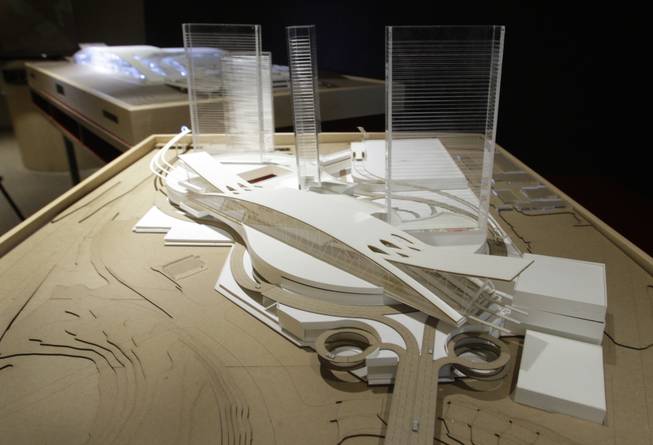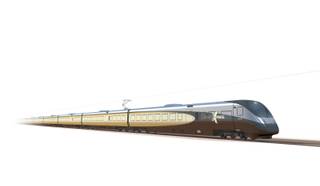
A model of a proposed Las Vegas station is displayed during a news conference for the DesertXpress high-speed rail project Thursday, March 25, 2010.
Friday, July 23, 2010 | 2:05 a.m.
Sun Coverage
- Work on high-speed rail set to begin this year (3-25-2010)
- Harry Reid: ‘No one is stopping’ maglev train proposal (3-19-2010)
- $45 million for maglev shifted to airport road project (3-17-2010)
- Las Vegas mob museum continues to move forward (11-18-2008)
- Not yet built, mob museum may get rival (9-11-2009)
- Goodman marks Mob Museum progress (8-4-2009)
- Mob museum contractor at odds with city (8-8-2009)
- Oh, the irony: The former mob lawyer gets FBI support for mob museum (8-17-2008)
When the DesertXpress high-speed train is built, there would be up to 700 permanent jobs at an operations and maintenance facility — in Victorville, Calif.
Tom Stone, president of DesertXpress Enterprises LLC, told representatives of the Associated General Contractors at a lunch Thursday that building the privately funded, $4 billion traditional high-speed rail system would create 50,000 person-year construction jobs over the four-year design and construction period expected to begin late this year.
Translated, 50,000 person-year jobs is the equivalent of 50,000 people working for a full year. The statistic illustrates the vast number and diverse types of jobs — planners, architects, draftsmen, engineers, construction workers, electricians and other specialists — that will be created over the course of the project.
But the bulk of the permanent operations jobs would be in Victorville, the southern terminus of 185-mile double-track system.
Stone said the decision to build the primary maintenance facility, which would include an operations control center, a train-washing facility, repair shop, parts storage, track storage, meeting rooms and administrative offices, was based on the availability of a 200 acre-plus, narrow piece of land in California.
“There’s no place large enough to accommodate this in Las Vegas,” Stone said. “Las Vegas will get more of its fair share of the construction jobs.”
Stone said the operations and maintenance center would start out with about 500 permanent jobs, growing to about 700 as ridership increases.
A smaller number of permanent jobs would be based in Southern Nevada for crews that would clean and inspect trains parked overnight in Las Vegas, Stone said. He didn’t have an estimate of how many jobs would be created here.
But contractors were enthused about the prospect of a long-term construction project.
Stone said his company is still awaiting final approval of an environmental impact statement before work can begin on the project. He said he hopes to get the environmental approvals by the end of summer so that some of the detailed engineering work could begin later this year and construction early next year.
Still undetermined is the exact location of train stations on both ends of the train line.
Three sites are proposed in the draft environmental impact statement for Victorville and four in Las Vegas.
Two of the four Las Vegas sites are near Flamingo Road and Interstate 15, while another is on the west side of I-15, near Russell Road. Another is in downtown Las Vegas.
The proposed station sites would have access to taxi service, car rental facilities and possible extensions of the Las Vegas Monorail line.
Environmental approvals are necessary because most of the route is on government land overseen by the Department of Transportation, the Bureau of Land Management and the National Park Service. The I-15 right-of-way would carry most of the route.
Stone said a series of announcements is expected in the weeks ahead when the environmental approvals are completed and the station sites are selected. The company also is expected to name a management group to operate the train.
The rail line is expected to be completed by 2014, and Stone said the cost of the project, operations and maintenance would be paid for by fare-box and advertising revenue and corporate sponsorships.
The average cost of a ticket would be about $50 one way, he said.
While the company’s focus is on building the line between Las Vegas and Victorville, another project that would solidify the viability of the system — a 50-mile rail link between Victorville and Palmdale, Calif. — remains under study.
The link to Palmdale would tie the DesertXpress route to California’s high-speed rail system.
Stone said it should be much easier to win environmental approvals on the route west to Palmdale compared with going south into the Los Angeles basin along I-15, because the route to Palmdale is undeveloped.
The rail line between Victorville and Palmdale is within the right-of-way of the so-called High Desert Corridor, a proposed freeway that would provide an alternate route into Southern California’s population centers.



Join the Discussion:
Check this out for a full explanation of our conversion to the LiveFyre commenting system and instructions on how to sign up for an account.
Full comments policy